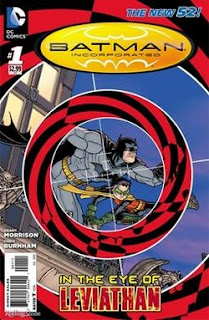In structural terms Grant Morrison’s Batman stories of the 2010s bid fair comparison with Dave Sim’s mammoth CEREBUS epic. Both are
less like novels, graphic or otherwise, than assemblages of inter-related
novels on the same themes. Here I’ll concern myself only with the culminating
storylines, the novels DEMON STAR and GOTHAM’S MOST WANTED, which are some though not all of the novels united
under the rubric BATMAN INC.
One of the overriding themes of Morrison’s Bat-pedia is that
of the relation of the hero to family. For these two novels, the core of this conflict is a
rewriting of the Barr/Bingham graphic novel, BATMAN: SON OF THE DEMON. Barr’s
script for SON, which I examined here, posits a situation in which Batman pretty much forgets about his
whole extended Bat-family for the sake of joining the house of Al Ghul. In
contrast, BATMAN, INC. brings many of the characters who comprise the Bat-family
into open conflict with Talia Al Ghul. Further, the Bat-family goes beyond the
protectors of Gotham, and extends to several Batman-emulators from other
countries: an Amerindian Batman, a
British Batman, and so on. In this
Morrison referenced a 1955 Bat-tale, “The Batmen of All Nations,” but the
Scottish author’s purpose goes beyond the simple gimmick of the original story.
Batman himself states one aspect of that purpose early in DEMON STAR, where the
hero meditates to himself, “The first truth of Batman. The saving grace. I was
never alone.”
Part of Morrison’s kaleidoscopic plot involves Batman having
had a vision of a terrible future, which may or may not come to fruition. But a
far more crucial thread, introduced in the arc BATMAN AND SON, deals with the
rewritten history of Batman’s interaction with Talia. In this version, Talia
drugs Batman in order to have sex with him, but instead of bearing his child
naturally, she has the fetus removed and raised through artificial means. Talia names the child Damian, apparently in
homage to THE OMEN, and when he reaches the age of ten she introduces Damian to
the father who never knew his son existed.
Given that Damian’s mother gave her son the same ruthless
League-of-Assassins training that she received from her father, the boy proves
a handful, to say the least. However, by the time of DEMON STAR, Damian has
become re-socialized enough that he can function as one of the crusader’s many
“boy wonders.”
However, Talia has had many more irons in the fire beyond
tormenting the hero with an unruly child. She’s taken over the League of
Assassins from her father, and has used the League’s super-science to create
clones of Damien, as well as co-opting
the “Man-Bat” serum from its inventor to
create a scourge of man-bat ninjas. Further, she creates a subversive
organization, Leviathan, in order to spread chaos in Gotham. She does all this
because in Morrison’s world, Batman does not choose her over the war on crime.
Leviathan, whatever the name portends in Biblical lore, is
one of the many incarnations of evil feminine will within the BATMAN INC.
storyline, and is joined by other such learned references as the Greek image of
the Medusa and the Hindu visage of Kali Ma. Still, references to myth aren’t
necessarily mythic in themselves; they have to take on their own resonance
within every new story.
Many Bat-writers, including Denny O’Neil, tended to sentimentalize
Talia Al Ghul, but Morrison does not. He presents snapshots of her early
history being raised by Ra’s Al Ghul, and the reader sympathizes with her,
especially when it’s strongly intimated that Talia’s mother Melisande was cast
aside by Ra’s when she got old, and that ultimately he had her killed. Further, for the first time, a writer suggests that Ra’s may have had a darker motive
for encouraging the union of his daughter and his foremost enemy: that Ra’s
wanted a grandson into whom the soul of Ra’s could be transferred, thus
insuring his continued immortality. But Talia is no better. She allows Damien
to bond with his father, but only with the hope that her son will eventually
choose mother over father. She also keeps in reserve one of the Damien-clones,
artificially grown to manhood and wearing the cowl of his “father.” The clone,
who is never even given the dignity of a name, ends up murdering his “brother”
and being murdered in turn by his mother. ”Leviathan has many children,” Talia
asserts, “Leviathan is mother to no one.”
I’ll have to pass
over a host of Morrisonian references, though I’ll mention that he excels in
his usage of the Medusa-imagery, and proceed to the Big Climax. In part it’s a
riff on “The Demon Lives Again,” since Talia beards Batman in his cave and
challenges him to a swordfight. However, she does so wearing some imitation
Bat-garments, which she quickly discards while mocking him: “I’ve beaten you at
your childish game of clues and traps, masks and toys.” Yet earlier Batman
perceives that her real animus is toward the father who ruthlessly used her,
and Talia’s fate is decreed, not a passing scorpion, but by one of the many
members of the extended Bat-family—one who was supposedly slain by the League
of Assassins years ago. Thus the Mother of Monsters is slain not by her mate,
but by one of his symbolic “daughters.”









No comments:
Post a Comment